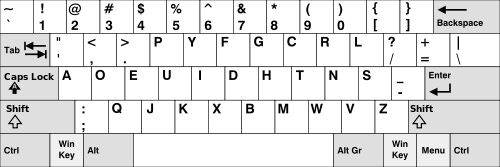Why We Need a Keyboard Revolution
One of the biggest myths in America is that the QWERTY keyboard was scientifically designed to be the most efficient key layout. Look at the point values the next time you play Words with Friends or Scrabble. The letters with lower point values are the easy letters to play because they’re used in the most words.
About 70 percent of words in the English language can be created using the letters DHIATENSOR, yet from that list, your fingers only touch "A," "S," "D," and "H" at their resting position on a QWERTY keyboard. Why are we stuck using such an inefficient method?
20 Best Cheap Mechanical Keyboards
Mechanical keyboards are in general, much better in terms of quality compared to standard membrane PC keyboards. They... Read more
Why QWERTY
The QWERTY layout dates back to the days of mechanical typewriters (the 1870s, to be more specific). We all know you can’t type as fast as you think and speak. What isn’t as well known is that this limitation was implemented on purpose — Remington adopted the layout on its typewriter specifically to slow down fast typists. If you typed too fast, you’d make the machine work harder and increase its chances of mechanical failure.
Needless to say, physical keyboards have evolved a lot in the last century and a half, so there’s no longer a need to slow ourselves down with these input methods. Not only that, technology is on the verge of completely removing mechanical boundaries with touch- and movement-based input.
Think you type fast? If you want to put your typing skills to a real test, try reconfiguring your keyboard to one of these QWERTY alternatives, Dvorak and Colemak, and see how you fare. (On Mac, Go to Keyboard > Input Sources > Dvorak to switch to the Dvorak layout.)
Dvorak:

Colemak:

(Image source: wikimedia.org)
Although introduced 70 years apart, both layouts are meant to be ergonomically correct and more intuitive than QWERTY. But touchscreens aren’t a perfect solution to our typing woes (as anyone who’s ever visited the site Damn You Autocorrect should know).
Autocorrect Isn’t Smart Enough
If our phones are so smart, autocorrect and predictive text really should know us better. The suggestions most systems provide show how far we have to go before our smartphones learn how to apply themselves.
On the technical side, autocorrect algorithms are evolving slightly, but there are still errors in the major virtual keyboard designs that are caused by mechanical limitations. Moving your finger over a glass screen produces random errors that amount to complete gibberish and have been known to occasionally crash your app or device.
Clearly, keyboard designers and smartphone manufacturers have a long way to go before the touchscreen is really perfected.
Typing, a Multi-Dimensional Problem
Make no mistake: the long-overdue keyboard revolution isn’t just dependent on the QWERTY layout or touchscreen technology. Typing is a multi-dimensional problem. Every person’s typing experience is unique, and the problems users face depend upon their language, behaviors, and personal typing quirks.
Even today, every language has a different keyboard layout, and each user has different expectations and seeks different features: touchscreens pose a unique challenge for users who are blind because they lack the tactile feedback of mechanical keyboards. Gamers tend to use certain keys more than the average user, including the "W," "A," "S," and "D."
When you look at how many variations of writing, sign language, and other communication methods we’ve come up with as humans, we need a variety of options to interact with our gadgets, merging many technologies between typing (seen as a business activity) and video games (seen as an entertainment activity).
How to Type Faster?
Living on the digital edge where typing is almost an everyday necessity, learning the ways of proper keyboard... Read more
The Race to Perfect the Typing Experience
Device manufacturers are acutely aware of users’ expanding typing needs — both on their home computers and their mobile touchscreen devices. They are in a race to provide a more seamless experience (especially on mobile) that makes typing on a smartphone just as easy and convenient as typing on a traditional mechanical or membrane keyboard.
The iPhone is so popular because it’s a great tool for creating and receiving content. The iPhone represents the apex of smartphone design, but it hasn’t yet perfected the content experience in China. The Chinese prefer a larger screen for prolonged reading and content consumption.)
Samsung already has bendable and foldable prototypes, Google Glass is nearing a full consumer launch phase, and everyone from the big guns at Microsoft to the little guys in garages are looking into creating fully interactive experiences within our homes, offices, and everywhere else we go.
Gesture-based input is advanced to the point where QWERTY, once a pain in our necks that was forced upon us, is now just a personal preference. Take Fleksy’s design, for instance, which gives users the option to use gestures instead of the spacebar or delete key.
8 Next-Generation User Interface That Are (Almost) Here
When we talk about user interface (UI) in computing, we're referring to how a computer program or system... Read more
In Conclusion
With all of this innovation, we hold on to QWERTY more out of nostalgia than anything else. The paradigm of buttons is quickly dying, and in a few generations, it’s possible that voice-activated AI assistants will fully saturate society (although I’m sure QWERTY, much like Linux, will always have a strong following). We need to rethink our expectations and perceptions of how we interact with our devices.
The infinite possibilities of UI presented by shifting trends in mobile and wearable technology open the door to reimagining how we interact and communicate with the world around us. Perhaps in the future, we won’t need to do very much typing at all, but in the meantime, we need a keyboard revolution.